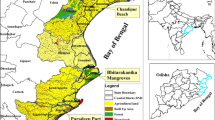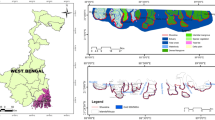Abstract
The coastal stretch of Rasulpur to Subarnarekha estuary approx. length of 70.42 km is potentially exposed and vulnerable due to coastal erosion along Bay of Bengal. The research strives to assess the vulnerability degree using composite index by geospatial quartiles system. Six triggering parameters (elevation, distance to river estuaries, land use/land cover, coastal slope, distance to coastline and historical shoreline change rate) are combined for Coastal Vulnerability Index (CVI). The resulting values have been classified with 4 CVI classes (very high, high, moderate and low vulnerability) according to quartiles statistics. The research demarked that half of the shoreline fell under moderate (CVI rank 2) to very highly vulnerable class (CVI rank 4). The degree of vulnerability along study area varies between 0.57 and 33.54 by CVI calculation. The shoreline of Old Digha, Rasulpur estuary, Digha estuary, Mandarmani estuary and Mandarmani has been fallen under rank 4. Rank of 3 is identified Udaipur, New Digha, Beguran Jalpai, Junput, Bankiput and Talsari. A few important beaches are identified under moderate vulnerable rank (Chandpur and Subarnarekha estuary). Only in three shorelines are found as low vulnerable index i.e., Shankarpur, Tajpur and Dadanpatrabar. The outcomes of vulnerability also provide valuable insightful information to coastal planners and decision makers for formulating the new strategies that are suitable for the study area and that also helpful for sustainable coastal management.











Similar content being viewed by others
References
Mujabar, S. P., & Chandrasekar, N. (2013). Coastal erosion hazard and vulnerability assessment for southern coastal Tamil Nadu of India by using remote sensing and GIS. Natural Hazards, 69, 1295–1314. https://doi.org/10.1007/s11069-011-9962-x
Bera, R., & Maiti, R. (2021). An assessment of coastal vulnerability using geospatial techniques. Environment and Earth Science, 80, 306. https://doi.org/10.1007/s12665-021-09616-4
Kim, K., Pant, P., & Yamashita, E. (2015). Evacuation planning for plausible worst case inundation scenarios in Honolulu Hawaii. Journal of Emergency Management, 13, 93–108.
O’Brien, G., O’Keefe, P., Rose, J., & Wisner, B. (2006). Climate change and disaster management. Disasters, 30(1), 64–80. https://doi.org/10.1111/j.1467-9523.2006.00307.x
Cutter, S. L., Mitchell, J. T., & Scott, M. S. (2000). Revealing the vulnerability of people and places: A case study of Georgetown County, South Carolina. Annals of the Association of American Geographers, 90(4), 713–737.
Parthasarathy, A., & Natesan, U. (2015). Coastal vulnerability assessment: A case study on erosion and coastal change along Tuticorin, Gulf of Mannar. Natural Hazards, 75(2), 1713–1729.
Gornitz, V. M. (1990). Vulnerability of the East Coast, USA to future sea level rise. Journal of Coastal Research, 9, 01–237.
Thieler, E. R., & Hammar-Klose, E. S. (1999). National assessment of coastal vulnerability to sea level rise, U.S. Atlantic coast. U.S. Geological Survey Open-File Report, 1999, 99–593.
Thieler, E. R., Hammer-Klose, E. S. (2000). National assessment of coastal vulnerability to sea-level rise: Preliminary results for the U.S. Pacific Coast, United States Geological Survey (USGS), Woods Hole, Mass, USA.
Das, S. (2012). The role of natural ecosystems and socio-economic factors in the vulnerability of coastal villages to cyclone and storm surge. Natural Hazards, 64, 531–546. https://doi.org/10.1007/s11069-012-0255-9
Gornitz, V. M., Daniels, R. C., White, T. W., & Birdwell, K. R. (1994). The development of a coastal risk assessment database: Vulnerability to sea-level rise in the U.S. southeast. Journal of Coastal Research, 12, 327–338.
Ozyurt, G., & Ergin, A. (2009). Application of sea level rise vulnerability assessment model to selected coastal areas of Turkey. Journal of Coastal Research, 1, 248–251.
Kumar, T. S., Mahendra, R. S., Nayak, S., Radhakrishnan, K., & Sahu, K. C. (2010). Coastal vulnerability assessment for Orissa State, East Coast of India. Journal of Coastal Research, 26, 523–534. https://doi.org/10.2112/09-1186.1
Hegde, A. V., & Reju, V. R. (2007). Development of coastal vulnerability index for Mangalore coast. India Journal of Coastal Research, 23(5), 1106–1111.
Woodruff, S., Vitro, K. A., BenDor, T. K. (2018). GIS and coastal vulnerability to climate change. University of North Carolina at Chapel Hill, NC, United States, pp. 236–257. https://doi.org/10.1016/B978-0-12-409548-9.09655-X.
Kunte, P. D., Jauhari, N., Mehrotra, U., Kotha, M., Hursthouse, A. S., & Gagnon, A. S. (2014). Multi-hazards coastal vulnerability assessment of Goa, India, using geospatial techniques. Ocean and Coastal Management, 95, 264–281. https://doi.org/10.1016/j.ocecoaman.2014.04.024
Cogswell, A., Greeman, B. J. W., & Greyson, P. (2018). Evaluation of two common vulnerability index calculation methods. Ocean and Coastal Management, 160, 46–51.
McLaughlin, S., & Cooper, J. A. G. (2010). A multi-scale coastal vulnerability index: A tool for coastal managers? Environ. Hazards, 9, 233–248.
Denner, K., Phillips, M. R., Jenkins, R. E., & Thomas, T. (2015). A coastal vulnerability and environmental risk assessment of Loughor Estuary South Wales. Ocean and Coastal Management, 116, 478–490. https://doi.org/10.1016/j.ocecoaman.2015.09.002
Preston, B. L., Yuen, E. J., & Westaway, R. M. (2011). Putting vulnerability to climate change on the map: a review of approaches, benefits, and risks. Sustainability Science, 6, 177–202.
Balica, S. (2012). Approaches of understanding developments of vulnerability indices for natural disasters. Environmental Engineering and Management Journal, 11, 963–974.
Cooper, M. J., Beevers, M. D., & Oppenheimer, M. (2008). The potential impacts of sea level rise on the coastal region of New Jersey, USA. Climate Change, 90(4), 475–492. https://doi.org/10.1007/s10584-008-9422-0
Pendleton, E. A., Thieler, E. R., Jeffress, S. W. (2005). Coastal vulnerability assessment of golden gate national recreation area to sea level rise, USGS Open-File Report 1058.
Mahamed, S. A. (2020). Coastal vulnerability assessment using GIS based multi criteria analysis of Alexandria-Northwestern Nile Delta, Egypt. Journal of African Earth Sciences, 163, 103751. https://doi.org/10.1016/j.jafrearsci.2020.103751
Ghosh, A., & Mukhopadhyay, S. (2017). Vulnerability assessment through index modeling a case study in Muriganga-Saptamukhi estuarine interfluve, Sundarban, India. Arabian Journal of Geosciences. https://doi.org/10.1007/s12517-017-3197-4
Jana, A., & Bhattacharya, A. K. (2013). Assessment of coastal erosion vulnerability around Midnapur-Balasore coast, eastern India using integrated remote sensing and GIS techniques. Journal of the Indian Society of Remote Sensing, 41, 675–686. https://doi.org/10.1007/s12524-012-0251-2
Rao, K. N., Subraelu, P., Venkateswara Rao, T., Hema Malini, B., Ratheesh, R., Bhattacharya, S., & Rajawat, A. S. (2008). Sea-level rise and coastal vulnerability: An assessment of Andhra Pradesh coast, India through remote sensing and GIS. Journal of Coastal Conservation, 12, 195–207.
Sambah, A. B., & Miura, F. (2013). Remote sensing, GIS and AHP for assessing physical vulnerability to tsunami hazard. International Journal of Environmental and Ecological Engineering, 7(10), 671–679.
Jana, A., Biswas, A., Maiti, S., & Bhattacharya, A. (2013). Shoreline changes in response to sea level rise along Digha coast, eastern India: An analytical approach of remote sensing, GIS and statistical techniques. Journal of Coastal Conservation, 18, 145–155. https://doi.org/10.1007/s11852-013-0297-5
Chatterjee, R. K. (1995). A comparative study between east and west Indian coast: A geographical account. Geographical Review of India, 12(1), 23–25.
Bhattacharya, A., Sarkar, S. K., & Bhattacharya, A. (2003). An assessment of coastal modification in the low lying tropical coast of north east India and role of natural and artificial forcings. International Conference on Estuaries and coasts China Hangzhou, 9–11, 158–165.
Dey, S., Ghosh, P., & Nayak, A. (2005). The influences of natural environment upon the evolution of sand dunes in tropical environment along Medinipur coastal area, India. Indonesian Journal of Geography, 37(1), 51–68.
Niyogi, D. (1970). Geology background of beach erosion at Digha. Geology Mineral Metal Society India, 19, 191–195.
Maiti, S., & Bhattacharya, A. K. (2009). Shoreline change analysis and its application to prediction: A remote sensing and statistics based approach. Marine Geology, 257(1), 11–23. https://doi.org/10.1016/j.margeo.2008.10.006
Paul, A. K. (2003). Coastal geomorphology and environment sundarbans coastal plain, Kanthi coastal plain, Subarnarekha delta plain. ACB publication, Kolkata. 2003.
Paul, S. K. (2006). Issues in coastal zone management of Digha-Shankarpur coastal area. ISRO-RSAM project report. RRSSC, Kharagpur.
Mukherjee, A., & Chatterjee, S. (1997). Coastal erosion and accretion at and around Digha in Medinipore district of West Bengal. Indian Journal of Geography and Environment, 2, 1–12.
Goswami, A. (1997). Medinipore coastal belt, West Bengal, a Morpho Stratiographic, Hydrologic and hydro chemical and appraisal.8th national symposium on hydrology, Jadavpur University, Calcutta, Proceeding Volume: 33–39.
Jana, A., & Bhattacharya, A. K. (2013). Assessment of coastal erosion vulnerability around Midnapur-Balasore coast, eastern India using integrated remote sensing and GIS techniques. Journal of the Indian Society of Remote Sensing, 41(3), 675–686.
Jana, A., Maiti, S., & Biswas, A. (2016). Analysis of short-term shoreline oscillations along Midnapur-Balasore coast, Bay of Bengal, India: A study based on geospatial technology. Modeling Earth Systems Environment, 2, 64. https://doi.org/10.1007/s40808-016-0117-7
Pendleton, E. A., Thieler, E. R., & Williams, S. J. (2010). Importance of coastal change variables in determining vulnerability to sea- and lake-level change. Journal of Coastal Research, 26(1), 176–183.
Barik, K. K., Mohanty, P. C., & Nanda, S. (2021). Earth observation technique-based coastal vulnerability assessment of northern Odisha, east Coast of India. Journal Indian Society Remote Sensing, 49, 293–303. https://doi.org/10.1007/s12524-020-01216-2
Nath, A., Koley, B., Saraswati, S., & Ray, B. C. (2021). Identification of the coastal hazard zone between the areas of Rasulpur and Subarnarekha estuary, east coast of India using multi-criteria evaluation method. Modeling Earth Systems and Environment, 7, 2251–2265. https://doi.org/10.1007/s40808-020-00986-5
Thieler, E. R., Himmelstoss, E. A., Zichichi, J. L., Ergul, A. (2019). The digital shoreline analysis system (DSAS) version 4.0 an ArcGIS extension for calculating shoreline change, US Geological Survey.
Mani Murali, R., Saran, A. K., Vethamony, P., & Jaya Kumar, S. (2006). Change detection studies in coastal zone features of Goa, India by Remote Sensing. Current Science, 91, 816–820.
Cohen, J. (1960). A coefficient of agreement for nominal scales. Educational and Psychological Measurement, 20, 37–46.
Bradley, B. A. (2009). Accuracy assessments of mixed land cover using a GIS-designed sampling scheme. International Journal of Remote Sensing, 30(13), 3515–3529.
Arkema, K. K., Gaunnel, G., Verutes, G., Wood, S. A., Guerry, A., Ruckelhaus, M., Kareiva, P., Lacayo, M., & Silver, J. M. (2013). Coastal habitats shield people and property from sea-level rise and storms. Nature Climate Change, 3, 913–918.
Yin, J., Yin, Z., Wang, J., & Xu, S. Y. (2012). National assessment of coastal vulnerability to sea-level rise for the Chinese coast. Journal of Coastal Conservation, 16, 123–133.
Hoque, M. A. A., Ahmed, N., Pradhan, B., & Roy, S. (2019). Assessment of coastal vulnerability to multi-hazardous events using geospatial techniques along the eastern coast of Bangladesh. Ocean and Coastal Management, 181, 104898. https://doi.org/10.1016/j.ocecoaman.2019.104898
Author information
Authors and Affiliations
Corresponding author
Ethics declarations
Conflict of interest
No conflict of interest declared by the authors.
Additional information
Publisher's Note
Springer Nature remains neutral with regard to jurisdictional claims in published maps and institutional affiliations.
All author(s) contributed equally and hence as the first author
Rights and permissions
Springer Nature or its licensor (e.g. a society or other partner) holds exclusive rights to this article under a publishing agreement with the author(s) or other rightsholder(s); author self-archiving of the accepted manuscript version of this article is solely governed by the terms of such publishing agreement and applicable law.
About this article
Cite this article
Nath, A., Koley, B., Choudhury, T. et al. Coastal vulnerability differentiated according to geospatial quartiles method: Rasulpur to Subarnarekha estuary, east coast of India. Spat. Inf. Res. (2023). https://doi.org/10.1007/s41324-023-00554-w
Received:
Revised:
Accepted:
Published:
DOI: https://doi.org/10.1007/s41324-023-00554-w




